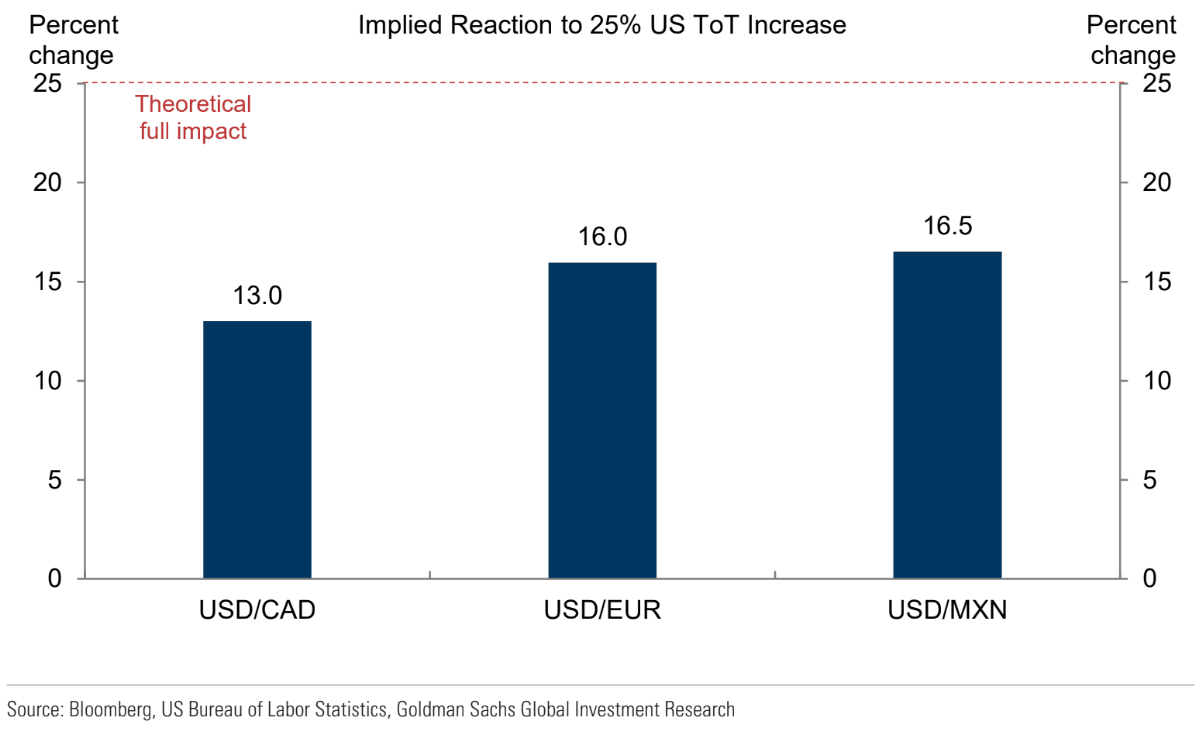Canadian Dollar Could Face A 13% Loss on Trump Tariff
- Written by: Gary Howes

Image © Adobe Stock
Goldman Sachs has looked at the potential impact of Donald Trump's tariffs on the Canadian Dollar and has quantified the potential scale of the loss that lies ahead.
Isabella Rosenberg, a Macro Strategist at Goldman Sachs, focussed on a hypothetical scenario where a US President-elect imposes a 25% tariff on all imports from Canada.
She notes that the immediate impact of such a tariff would represent a positive terms of trade shock for the US, meaning the relative price of US exports would increase compared to its imports. This typically leads to an appreciation of the imposing country's currency.
Based on a model examining the historical relationship between exchange rates and terms of trade, Rosenberg estimates that a 25% tariff could result in a 13% appreciation of USD/CAD.
However, she cautions that this is a theoretical upper bound and the actual impact on the CAD is likely to be less severe.
The research comes in the wake of an unexpected intervention by President-elect Trump on Monday night when he threatened a 25% tariff on Mexico and Canada for failures to stem illegal migration into the U.S.
The Canadian Dollar fell by more than a per cent against the Dollar and closed the day 0.80% lower against the Euro and Pound.
According to Goldman Sachs' research, this would be the beginning of a much larger fall for CAD.
📈 Q2 Investment Bank Forecasts for GBP vs. CAD. See the Median, Highest and Lowest Targets for the Coming Months. Request your copy now.
Rosenberg highlights several factors that could mitigate the full pass-through of the tariff to the exchange rate:
Exchange Rate Adjustments: The CAD may only partially depreciate in response to the tariff.
US Consumer Prices: US consumers might bear some of the tariff burden through higher prices for Canadian goods.
US and Canadian Firm Margins: Both US and Canadian businesses could absorb a portion of the tariff cost by reducing their profit margins.
Canada's Negotiating Power: Canada may be able to shift a significant portion of the tariff burden onto the US, particularly for essential commodities and complex products that are difficult to source elsewhere.
Monetary Policy Response: The Bank of Canada's monetary policy decisions in response to the economic effects of the tariffs could also influence the CAD's value. A more dovish policy stance aimed at stimulating the Canadian economy could further weaken the CAD.
Rosenberg acknowledges that a 25% tariff on all Canadian imports is unlikely, given that the most significant contributor to Canada's trade imbalance with the US is crude oil.
She believes US tariffs on oil imports are improbable due to the potential for increased gasoline prices and the US refining system's reliance on Canadian heavy crude.
Besides the direct impact of tariffs, Rosenberg identifies additional factors that could influence USD/CAD:
USMCA Renegotiation: The upcoming renegotiation of the USMCA trade agreement in 2026 injects uncertainty into the outlook for USD/CAD.
This uncertainty could result in a sustained risk premium embedded in the exchange rate, keeping USD/CAD elevated.
Domestic Economic Factors: The interplay of domestic economic conditions in both the US and Canada will also play a role in shaping the trajectory of USD/CAD.
Rosenberg concludes that the combination of tariff risks and domestic economic factors is likely to contribute to an elevated USD/CAD in the near future.
However, she anticipates that the weaker domestic backdrop will be the primary driver, with tariff risks playing a more significant role when they align with the prevailing macroeconomic trends.





